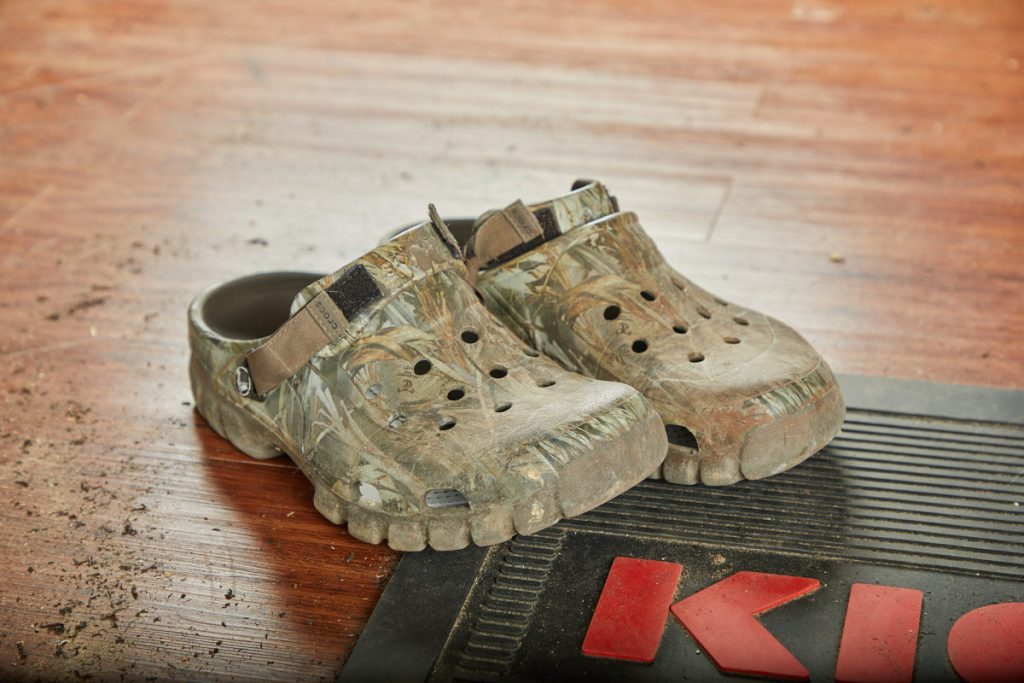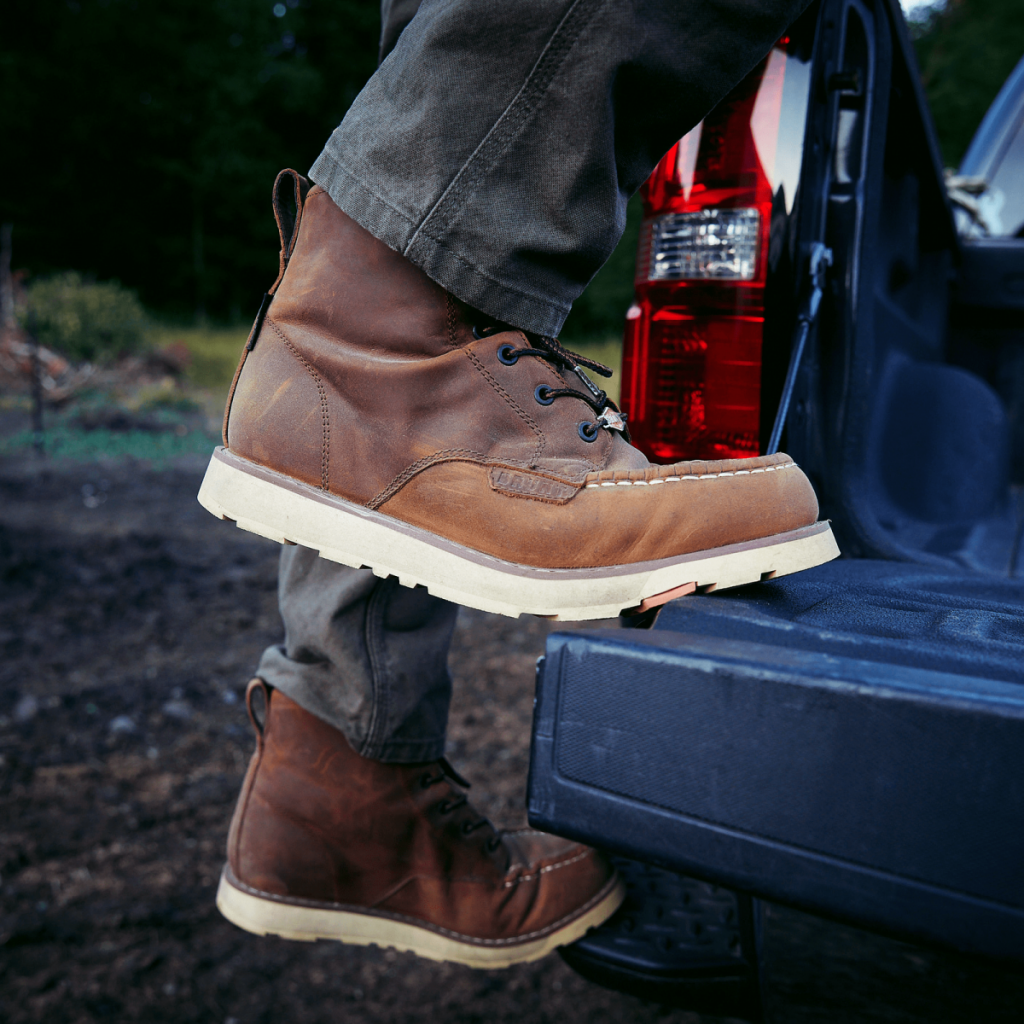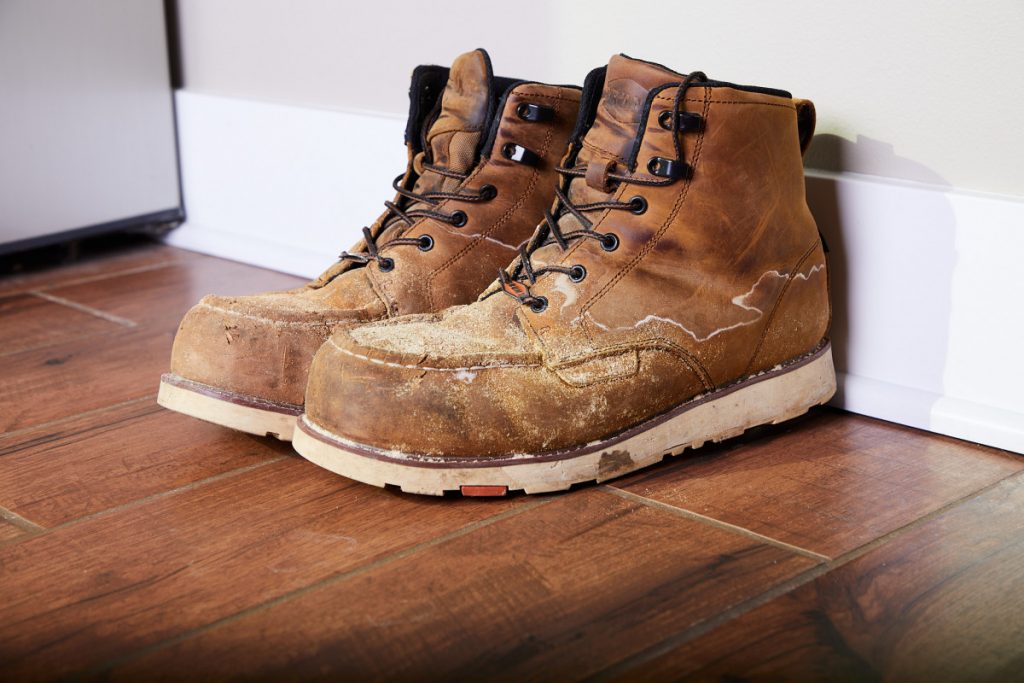We may receive a commission when you use our affiliate links. However, this does not impact our recommendations.
I don’t know about you, but when I’m working in the shop, I usually try and carve out at least a few hours. Enough time to make some progress on a project at least. Often, this means standing for long periods of time. And, while I do what I can to try and have anti-fatigue mats in the most used areas, I often notice that my feet are sore long before my wife’s beckoning me to come upstairs, or other duties call me out of the shop. While it may not be the fanciest tool or nicest piece of lumber, I think it’s worthwhile to take a glance down at your footwear and give your feet a fighting chance.
When I look at work shoes, I try and take into account a handful of criteria: Price, Comfort, Weight, Safety (slip and crush), flexibility, and convenience. Below, I’ll go through a handful of different options I’ve worn in my shop and my ratings for each.
Good: Slip-On Options

The most fashion forward? Nope. But, they work for quick trips into the shop to grab something.
With my shop being located in my basement, I’m often stepping in and out of the shop just to grab something. A screwdriver, drill, etc. Walking into the shop in my socks is a recipe for disaster. Not only am I liable to step in some uncured glue or slip in sawdust, but I’m bound to pick up a string of lathe shavings and trail them up the stairs. I don’t know which is more dangerous to my health…slipping on sawdust or trailing it throughout the house. With that said, I always keep a pair of “slip-on” shoes right inside the shop door. Slip-on tennis shoes would be fine, but I’m often walking into the shop with my arms full, so I want something quick to get on, no hands necessary. Enter the shop croc. That’s right. I keep a pair of crocs right inside my shop door, and I’m not ashamed of it. Well, maybe I’m a little ashamed. But that’s ok. There’s nothing better for met o slip on and walk through the piles of sawdust, and be able to kick off as I exit the shop. Now, I’m not saying that these are a good option for normal shop use. Crocs, while comfortable, aren’t great to stand on concrete all day. And, they offer little protection in event of a heavy item getting dropped (or worse, a sharp tool). However, for quick in-and-out situations, they’re perfect. (The camo was a bass-pro special…They also double as my camp shoes).
- Price: 7/10 – Reasonably priced. For what they are, they’re kind of pricey, ($55-$65 on Amazon) but they’re less than other options.
- Comfort: 7/10 -Moderate.
- Weight: 10/10 – Excellent (like wearing a feather – I have flip-flops that are heavier).
- Safety: 3/10 – Very little. They will protect from small items getting dropped on them, but a sharp chisel or heavy wood will do damage.
- Flexibility: 8/10 – Not limited to the shop. As I mentioned, they double as my camping shoes, mowing shoes, and other general “outside” shoe. At least where my neighbors won’t see me wearing them.
- Convenience: 9/10 – High -They’re sitting there waiting for my feet right in the door. The only reason they’re not a 10/10 is that occasionally, the “four-wheel drive” strap gets flipped down and is an inconvenience.
Better: Tennis Shoes
In my day-to-day, tennis shoes are usually my go-to. I’m in and out of the various shops and studios, running around, and spending time at my desk. Tennis shoes are a great all-around option. They have a handful of benefits over the slip-on options. They offer (usually) better arch support. They’re also more comfortable than slip-on shoes. If you decide to go the tennis shoe route, take a look for shoes that are “Slip-resistant”. In my shop, I have a linoleum tile floor that gets very slick when it gets covered in dust. I know that concrete can be the same way, especially if you have an epoxy coating on your floor. Spending a little extra money on shoes that have a grippy tread on the bottom is well worth it. The biggest thing with tennis shoes, at least for me, is they tend to be my everyday shoe. So, I try and keep them decent-looking as long as I can. That doesn’t always happen in the shop. I have various shoes with glue and finish stains all over them.
- Price: 5/10 – A decent pair of tennis shoes will set you back $80. And, I’ve found that you often get what you pay for, so the more you pay, generally (but not always) the better the shoe.
- Comfort: 8/10 – A broken-in pair of tennis shoes are usually comfortable.
- Weight: 7/10 – Good, but depends on the brand.
- Safety: 5/10 – Better than crocs, but not by much. A sharp chisel would still get through the fabric top of my tennis shoes, but if they were leather, they might offer more protection. Still don’t drop anything on your foot, however — there’s no crush protection here.
- Flexibility: 9/10 – Except for the dressiest of occasions, tennis shoes are a pretty utilitarian option. From the shop to getting groceries, to sitting at my desk.
- Convenience: 8/10 – High – So, I have to tie them on, not that big of a deal. I like that I can often “Freshen” my tennis shoes up and clean off any embedded sawdust by tossing them into the washing machine.
Best: Work Boots

When it comes to being on your feet for a long time and safety, the work boot is the king of them all. Depending on the style, work boots offer ankle support for working outside, steel (or composite) toes for protection, and leather outside for durability.
Now, I’m going to take a second and do a product plug, which I don’t usually do. Back in September/October, BRUNT got a hold of me and asked if they could send me a pair of boots to try out. For the last four months, I’ve been wearing their Marin Comp Toe Boot everywhere I can … When I’m out running the sawmill, working in the shop, stacking lumber, plowing snow, etc. I have to say, I’ve never appreciated the saying “there’s nothing like a good pair of work boots” until now. I’m dearly in love with these. I’ve owned many brands of boots that will go unnamed, and from a “work boot” standpoint, these are hands down the winners. Outside, they’re waterproof if I’m running the sawmill in the rain (which I hate doing, but it happens). The composite toe has saved me more than its fair share of smashed toes from dropped boards and slabs (doesn’t do anything for my shins, however). And, here’s the great thing…They’re amazingly comfortable. I waited four months to share my thoughts on these, as I wanted to make sure I wore them enough to give an accurate report on them. As I mentioned, they sent me this pair, but when they’re ready to be replaced, you bet your britches that I’ll be buying a new pair. End product plug.

My Marin Comp Toe after 4 months of HARD sawmilling and working in the shop. Notice the water line — sawmilling in the snow, and they’re certainly waterproof.
Are work boots overkill for what you do in your shop? Maybe. But if you’ve ever dropped something on your foot, or slipped on your floor, it might be worth looking at a pair.
- Price: 8/10 – If you buy a decent pair, they’ll last a long while. Pricing might be higher than the other options (slip-ons, or tennis shoes), but I think you’ll get a better value and longer life out of these. The Marin Comp Toe Boot is $145 from BRUNT.
- Comfort: 10/10 – Without a doubt, the Marin is the most comfortable footwear that I’ve ever put on. It took a few weeks to get to that point, but once they were broken in, it’s like slipping a well-worn leather glove on.
- Weight: 6/10 – Quality workboots are going to be heavier than the other options. It is what it is.
- Safety: 9/10 – Steel or composite toes protect against crush hazards. The leather uppers of most work boots will protect against sharp objects.
- Flexibility: 8/10 – My wife, who is my fashion “consultant” (although, I call her my fashion critic?), loves the way these boots look. She doesn’t like that I always have them filthy (I’m working in them after all), but when they were new and clean, she liked the looks of these better than my tennis shoes.
- Convenience: 6/10 – Lace-up work boots. They take longer to put on than other types of footwear. Once they’re on, they’re not coming off and they are great. I will also say, I prefer to wear long socks with the 8″-high boots. I have old wool hunting socks hanging around that I wear with them, but BRUNT also sells Socks and Insoles. Full disclosure: I haven’t tried their socks and insoles, but if they’re as good as their boots, you’ll love them.
Here are some supplies and tools we find essential in our everyday work around the shop. We may receive a commission from sales referred by our links; however, we have carefully selected these products for their usefulness and quality.









